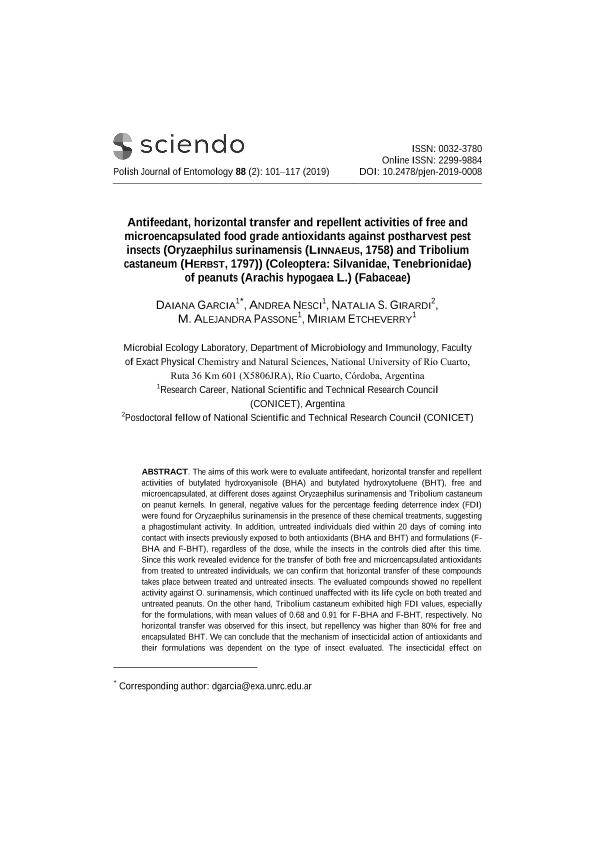Artículo
Antifeedant, horizontal transfer and repellent activities of free and microencapsulated food grade antioxidants against postharvest pest insects (Oryzaephilus surinamensis (Linnaeus, 1758) and Tribolium castaneum (Herbst, 1797)) (Coleoptera: Silvanidae, Tenebrionidae) of peanuts (Arachis hypogaea L.) (Fabaceae)
García, Daiana ; Nesci, Andrea Verónica
; Nesci, Andrea Verónica ; Girardi, Natalia Soledad
; Girardi, Natalia Soledad ; Passone, Maria Alejandra
; Passone, Maria Alejandra ; Etcheverry, Miriam Graciela
; Etcheverry, Miriam Graciela
 ; Nesci, Andrea Verónica
; Nesci, Andrea Verónica ; Girardi, Natalia Soledad
; Girardi, Natalia Soledad ; Passone, Maria Alejandra
; Passone, Maria Alejandra ; Etcheverry, Miriam Graciela
; Etcheverry, Miriam Graciela
Fecha de publicación:
06/2019
Editorial:
Sciendo
Revista:
Polish Journal of Entomology
ISSN:
0032-3780
e-ISSN:
2299-9884
Idioma:
Inglés
Tipo de recurso:
Artículo publicado
Clasificación temática:
Resumen
The aims of this work were to evaluate antifeedant, horizontal transfer and repellent activities of butylated hydroxyanisole (BHA) and butylated hydroxytoluene (BHT), free and microencapsulated, at different doses against Oryzaephilus surinamensis and Tribolium castaneum on peanut kernels. In general, negative values for the percentage feeding deterrence index (FDI) were found for Oryzaephilus surinamensis in the presence of these chemical treatments, suggesting a phagostimulant activity. In addition, untreated individuals died within 20 days of coming into contact with insects previously exposed to both antioxidants (BHA and BHT) and formulations (F- BHA and F-BHT), regardless of the dose, while the insects in the controls died after this time. Since this work revealed evidence for the transfer of both free and microencapsulated antioxidants from treated to untreated individuals, we can confirm that horizontal transfer of these compounds takes place between treated and untreated insects. The evaluated compounds showed no repellent activity against O. surinamensis, which continued unaffected with its life cycle on both treated and untreated peanuts. On the other hand, Tribolium castaneum exhibited high FDI values, especially for the formulations, with mean values of 0.68 and 0.91 for F-BHA and F-BHT, respectively. No horizontal transfer was observed for this insect, but repellency was higher than 80% for free and encapsulated BHT. We can conclude that the mechanism of insecticidal action of antioxidants and their formulations was dependent on the type of insect evaluated. The insecticidal effect on Oryzaephilus surinamensis could have been due to the direct intake of the chemical compounds added, whereas the negative effect on Tribolium castaneum could have been caused by starvation.
Archivos asociados
Licencia
Identificadores
Colecciones
Articulos(CCT - CORDOBA)
Articulos de CTRO.CIENTIFICO TECNOL.CONICET - CORDOBA
Articulos de CTRO.CIENTIFICO TECNOL.CONICET - CORDOBA
Citación
García, Daiana; Nesci, Andrea Verónica; Girardi, Natalia Soledad; Passone, Maria Alejandra; Etcheverry, Miriam Graciela; Antifeedant, horizontal transfer and repellent activities of free and microencapsulated food grade antioxidants against postharvest pest insects (Oryzaephilus surinamensis (Linnaeus, 1758) and Tribolium castaneum (Herbst, 1797)) (Coleoptera: Silvanidae, Tenebrionidae) of peanuts (Arachis hypogaea L.) (Fabaceae); Sciendo; Polish Journal of Entomology; 88; 2; 6-2019; 101-117
Compartir
Altmétricas



